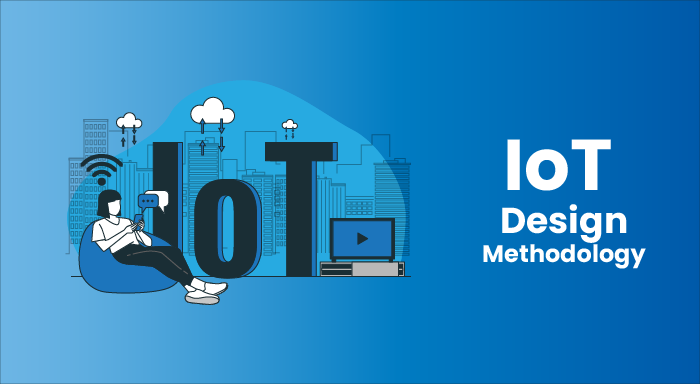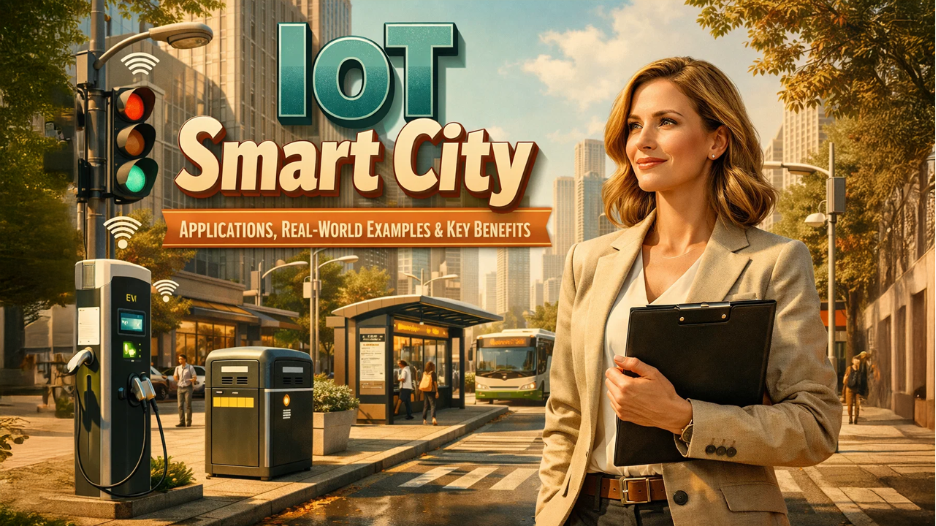As per 2025 data, there are already close to 19 billion devices in the world. Furthermore, the number of devices is growing steadily at 13% and the number will likely go beyond 40 billion by 2030. IoT has without a doubt transformed our current world, transforming distinct industries around the globe. It impacts our routine processes in ways we cannot even imagine. Starting from aiding us in determining how to travel, how we purchase products, to high stake business decisions, the application of IoT is everywhere. IoT is a mixture of numerous devices that can be anything from simple wearables and industrial machinery to costly medical appliances. It involves diverse technologies like IoT actuators, sensors, cloud computing, high-speed transfer of data, RF communication, etc. In order to implement IoT technology, it is necessary to have an in-depth conceptual understanding of IoT design methodology.
Understanding IoT Design Methodology- Overview
Developing IoT platforms is a fully technical and complex task involving tricky challenges. It is essential to establish seamless connections between various systems to ensure smooth data exchange. However, for every component and facet, IoT developers can choose between various options. To make the right choice, IoT engineers must keep the design aligned with their products and objectives. In this blog, we will mainly concentrate on general design methodology. It will be true regardless of your product, service, or language. The overall design of your IoT ecosystem can then further impact your design time, testing time, maintenance time, complexity, and interoperability. Thus, it is imperative to have an IoT design methodology absolutely perfect. Explore this blog to learn more.
Methodology Steps
The basic design methodology for an IoT ecosystem is explained in-depth in the following points-
Purpose And Requirement
Determining the overall purpose and requirements of the system is the very first step. This step involves defining the behavior, requirements, and the needs of the platform. The requirements are listed as follows:
- User interface requirements
- Data collection requirements
- Data analysis requirements
- Security standards
- System management prerequisites.
Procedure Detail
This step converts the determined requirements and goals into precise application areas of the IoT platform. It describes how distinct components interact, what processes will be performed, and the precise conditions under which they will be performed. Every procedure showcases a proper functional flow, enabling developers to comprehend system behavior before proceeding to the modeling phase.
Domain Model Specification
The third step in the IoT design methodology is the domain model specification. The domain model showcases the main entities, concepts, and objects in the IoT system domain which will be generated. The domain model defines the object properties and their connections. It is not dependent on any technology or platform.
The system designers can understand the IoT domain for which the platform is designed through domain models.
Information Model Specification
In this step, the overall information model is determined. Essentially, the information model defines the complete information architecture of IoT platforms, including virtual entity properties, relationships, and other structures. These models don’t go into great detail about the storage and display of data.
Service Specification
The services in the IoT ecosystem including input/outputs, service types, schedules, endpoints, effects, preconditions, etc., are defined in this step by service specifications.
Such services either retrieve the present value, change the state, or allocate values. The mode service is a kind of RESTful web service that might be utilized for GET Request or PUT Request. The mode is either retrieved from the database or updated to the database. The state service is a kind of RESTful web service that enables users to receive the present light state (GET Request) or set the status of light appliance as off or on (PUT Request).
This status is either retrieved or updated in the status database. On the device, the controller service works as a native service.
Also Read- Communication Protocols In IoT
IoT Specification
In this state of IoT design methodology, IoT developers must work toward defining the IoT levels of the system. Five distinct deployment levels are utilized depending on diverse circumstances:
- IoT Level 1
- IoT Level 2
- IoT Level 3
- IoT Level 4
- IoT Level 5
Functional View Specification
The functions of IoT systems are classified into distinct functional groups as per the functional groups. Each functional group offers details related to the functionalities and ideas for interaction in the domain model.
A functional view includes the below-mentioned functional groups:
- Management
- Application
- Security
- Communication
- Device
- Services
Operational View Specification
In the IoT design methodology, this step is related to determining the operational view specifications. The operation and deployment of IoT platforms are defined. This involves options for service storage, hosting, application hosting, device hosting, storage, etc.
Component and Device Integration-
This step includes incorporating component designs and devices. It includes an LDR sensor, IoT actuators, and a microcomputer.
Application Building-
This is the final phase in the IoT design methodology. Its purpose is to build an IoT application. The application has the controls for light (on or off) or mode (auto-on or auto-off).
Significance of IoT Design Methodology
Improved Performance-
Prudently selecting an IoT design minimizes delays, ensures reliable data delivery, and conserves energy. This enhances overall reliability and performance of the system.
Cost Efficiency
Consumers and businesses can minimize costs by utilizing an effective IoT design. It minimizes overall cost of ownership, development expenses, and maintenance costs.
Ecosystem Integration-
Seamless integration with other platforms is also vital. Distinct devices and platforms can also easily exchange data and collaborate effectively with particular design methodology in IoT.
Innovation and Differentiation-
The key is to differentiate your brand and create fresh ideas. New services, features, and business strategies are based on effective IoT design.
Future Outlook and Real-World Applications
The upcoming future of IoT design methodology looks to be promising with greater number integrations across various industries. Now, we have futuristic technologies such as edge computing, 5G, and AI elevating capabilities of the system. Applications in the real-world showcase the revolutionary potential of expert-built IoT platforms. Smart cities leverage strongly interconnected sensors for managing energy optimization and traffic. In the healthcare industry, healthcare providers utilize wearable devices for consistent tracking of patients and predictive diagnostics.
In the manufacturing industry, Industry 4.0 implementations demonstrate how effective IoT design methodology allows predictive maintenance, minimizing downtime by as much as 50%. Agricultural IoT platforms track weather patterns, soil conditions, and crop health, streamlining yields while also preserving resources. Retail environments utilize smart inventory tracking platforms and shelves that rearrange products automatically and asses patterns of customer behavior.
As we approach 2030, the incorporation of machine learning algorithms with IoT systems will allow autonomous capabilities for decision-making. Edge computing can minimize latency and enhance responsiveness in real-time while latency and quantum computing can revolutionize processing speeds and encryption of data. The integration of such
As we approach 2030, the incorporation of machine learning algorithms with IoT systems will allow autonomous capabilities for decision-making. Edge computing can minimize latency and enhance responsiveness in real-time while latency and quantum computing can revolutionize processing speeds and encryption of data. The integration of such technology will generate unforeseen opportunities for innovation, ensuring that design methodology not just remain a technical necessity but also a strategic advantage for global businesses.
Summing It Up
We can conclude that IoT is the comprehensive force behind generating efficient, smart, and securely connected platforms that drive various industries. Just by focusing on security protocols, user experience, and smooth compatibility, IoT has created new avenues for intensive digitization. IoT design methodologies revolutionize industry operations, spark innovation, and create solutions that improve daily life.
IoT design has modified our interaction with our surroundings and paved the path for smart homes and industrial automation. This is where internet of things development services play a vital role, offering tailored solutions that align with specific business needs and industry standards. By staying at the forefront of IoT advancements, business can shape their future for seamless integration into our lives, delivering unparalleled convenience, safety, and connectivity.
FAQs for IoT Design Methodology
- What are the key components of an IoT system?
Key Components are those factors that are completely responsible for the entire functioning of the system or technology. Here the key components of IoT devices are sensors, actuators, microcontrollers, connectivity, and data processing.
- What design considerations should be made for IoT systems?
There are several design considerations that should be made for IoT systems such as scalability, Security, interoperability, and reliability. Furthermore, data management, regulatory compliance, cost of the devices, user experience, and a list of others.
- How do you ensure security in an IoT design?
Generally, IoT (Internet of Things) is designed to be secure but here are the few components that will assist you in determining the security of the Iot tools. To do this, you can use network segmentation, data encryption, regular updates, best practices, and so on.
- What role does data analytics play in IoT design?
Data analytics play the biggest role in the IoT design process that assists businesses in driving informed decisions based on data of the IoT devices. Here they help in improving the products, fixing the issues, managing large volume data, driving actionable decisions, and a list of others.
- What are the common IoT communication protocols used in design?
There is a long list of IoT communication protocols that are used in the design process. However, here are a few of them— Zigbee, MQTT (Message Queue Telemetry Transport), AMQP (Advance Messaging Queue Protocol), and more.
Related Posts



